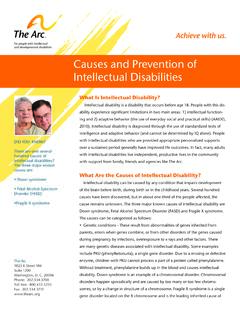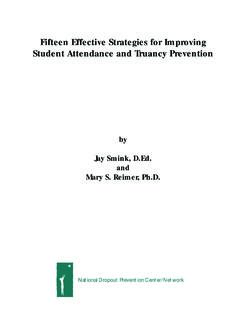Transcription of Morbidity and Mortality Weekly Report
1 Morbidity and Mortality Weekly ReportRecommendations and ReportsDecember 16, 2005 / Vol. 54 / No. RR-15 INSIDE: Continuing Education Examinationdepardepardepardepardepartmen t of health and human sertment of health and human sertment of health and human sertment of health and human sertment of health and human servicesvicesvicesvicesvicesCenters for Disease Control and PreventionCenters for Disease Control and PreventionCenters for Disease Control and PreventionCenters for Disease Control and PreventionCenters for Disease Control and PreventionGuidelines for the Investigation of Contactsof Persons with Infectious TuberculosisRecommendations from the National TuberculosisControllers Association and CDCG uidelines for Using the QuantiFERON -T BGold Test for Detecting Mycobacteriumtuberculosis Infection.
2 United StatesMMWRCONTENTSG uidelines for the Investigation of Contactsof Persons with Infectious 1 Decisions to Initiate a Contact 4 Investigating the Index Patient and Sites of 6 Assigning Priorities to 9 Diagnostic and Public Health Evaluation of 11 Treatment for Contacts with 16 When to Expand a Contact 19 Communicating Through the 20 Data Management and Evaluation of Contact Investigations . 21 Confidentiality and Consent in Contact 23 Staffing and Training for Contact 23 Contact Investigations in Special 24 Source-Case 31 Other 33 Appendix 39 Appendix 43 Continuing Education CE-1 Guidelines for Using the QuantiFERON -TB GoldTest for Detecting Mycobacterium tuberculosisInfection, United 50 Indications for QFT-G.
3 51 How QFT-G Testing is Performed and 51 Cautions and 51 Additional Considerations and Recommendationsin the Use of QFT-G in Testing 52 Future Research 54 The MMWR series of publications is published by theCoordinating Center for Health Information and Service,Centers for Disease Control and prevention (CDC), of Health and Human Services, Atlanta, GA for Disease Control and PreventionJulie L. Gerberding, MD, MPHD irectorDixie E. Snider, MD, MPHC hief Science OfficerTanja Popovic, MD, PhDAssociate Director for ScienceCoordinating Center for Health Informationand ServiceSteven L. Solomon, MDDirectorNational Center for Health MarketingJay M. Bernhardt, PhD, MPHD irectorDivision of Scientific CommunicationsMaria S. Parker(Acting) DirectorMary Lou Lindegren, MDEditor, MMWR SeriesSuzanne M.
4 Hewitt, MPAM anaging Editor, MMWR SeriesTeresa F. Rutledge(Acting) Lead Technical Writer-EditorJeffrey D. Sokolow, MAProject EditorBeverly J. HollandLead Visual Information SpecialistLynda G. CupellMalbea A. LaPeteVisual Information SpecialistsQuang M. Doan, MBAE rica R. ShaverInformation Technology SpecialistsSUGGESTED CITATIONC enters for Disease Control and prevention . Guidelines forthe investigation of contacts of persons with infectioustuberculosis; recommendations from the National TuberculosisControllers Association and CDC, and Guidelines for usingthe QuantiFERON -TB Gold test for detectingMycobacterium tuberculosis infection, United States. MMWR2005;54(No. RR-15):[inclusive page numbers].Disclosure of RelationshipCDC, our planners, and our content experts wish to disclose theyhave no financial interests or other relationships with themanufacturers of commercial products, suppliers of commercialservices, or commercial supporters.
5 Presentations will not includeany discussion of the unlabeled use of a product or a product underinvestigational 54 / RR-15 Recommendations and Reports1 Guidelines for the Investigation of Contactsof Persons with Infectious TuberculosisRecommendations from the National TuberculosisControllers Association and CDCS ummaryIn 1976, the American Thoracic Society (ATS) published brief guidelines for the investigation, diagnostic evaluation, andmedical treatment of TB contacts. Although investigation of contacts and treatment of infected contacts is an important compo-nent of the strategy for TB elimination, second in priority to treatment of persons with TB disease, national guidelines havenot been updated since statement, the first issued jointly by the National Tuberculosis Controllers Association and CDC, was drafted by a workinggroup consisting of members from both organizations on the basis of a review of relevant epidemiologic and other scientific studiesand established practices in conducting contact investigations.
6 This statement provides expanded guidelines concerning investiga-tion of TB exposure and transmission and prevention of future cases of TB through contact investigations. In addition to the topicsdiscussed previously, these expanded guidelines also discuss multiple related topics ( , data management, confidentiality andconsent, and human resources). These guidelines are intended for use by public health officials but also are relevant to others whocontribute to TB control efforts. Although the recommendations pertain to the United States, they might be adaptable for use inother countries that adhere to guidelines issued by the World Health Organization, the International Union against Tuberculosisand Lung Disease, and national TB control 1962, isoniazid (INH) was demonstrated to be effectivein preventing tuberculosis (TB) among household contacts ofpersons with TB disease (1).
7 Investigations of contacts andtreatment of contacts with latent TB infection (LTBI) becamea strategy in the control and elimination of TB (2,3). In 1976,the American Thoracic Society (ATS) published brief guide-lines for the investigation, diagnostic evaluation, and medicaltreatment of TB contacts (4). Although investigation of con-tacts and treatment of infected contacts is an important com-ponent of the strategy for TB elimination, second inpriority to treatment of persons with TB disease, nationalguidelines have not been updated since statement, the first issued jointly by the National Tuber-culosis Controllers Association (NTCA) and CDC, was draftedby a working group consisting of members from both organi-zations on the basis of a review of relevant epidemiologic andother scientific studies and established practices in conductingcontact investigations.
8 A glossary of terms and abbreviationsused in this Report is provided (Box 1 and Appendix A).This statement provides expanded guidelines concerninginvestigation of TB exposure and transmission and preven-tion of future cases of TB through contact investigations. Inaddition to the topics discussed previously, these expandedguidelines also discuss multiple related topics ( , data man-agement, confidentiality and consent, and human resources).These guidelines are intended for use by public health offi-cials but also are relevant to others who contribute to TB con-trol efforts. Although the recommendations pertain to theUnited States, they might be adaptable for use in other coun-tries that adhere to guidelines issued by the World HealthOrganization, the International Union Against Tuberculosisand Lung Disease, and national TB control investigations are complicated undertakings thattypically require hundreds of interdependent decisions, themajority of which are made on the basis of incomplete data,and dozens of time-consuming interventions.
9 Making suc-cessful decisions during a contact investigation requires use ofa complex, multifactor matrix rather than simple decision each factor, the predictive value, the relative contribu-tion, and the interactions with other factors have beenincompletely studied and understood. For example, the dif-The material in this Report originated in the National Center for HIV,STD, and TB prevention , Kevin Fenton, MD, PhD, Director, and theDivision of Tuberculosis Elimination, Kenneth G. Castro, MD, preparer: Zachary Taylor, MD, National Centerfor HIV, STD, and TB prevention , CDC, 1600 Clifton Road, NE,MS E-10, Atlanta, GA 30333. Telephone: 404-639-5337; Fax:404-639-8958; E-mail: 16, 2005ferences between brief, intense exposure to a contagiouspatient and lengthy, low-intensity exposure are have confirmed the contribution of certain factors:the extent of disease in the index patient, the duration thatthe source and the contact are together and their proximity,and local air circulation (5).
10 Multiple observations have dem-onstrated that the likelihood of TB disease after an exposureis influenced by medical conditions that impair immunecompetence, and these conditions constitute a critical factorin assigning contact priorities (6).Other factors that have as yet undetermined importanceinclude the infective burden of Mycobacterium tuberculosis,previous exposure and infection, virulence of the particularM. tuberculosis strain, and a contact s intrinsic predispositionfor infection or disease. Further, precise measurements ( ,duration of exposure) rarely are obtainable under ordinarycircumstances, and certain factors ( , proximity of exposure)can only be approximated, at safe exposure time to airborne M. tuberculosis has beenestablished.















